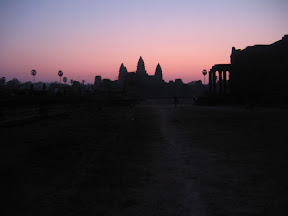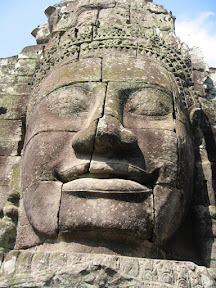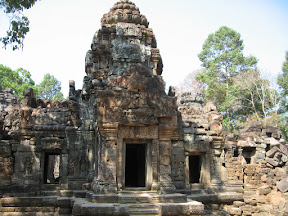
Angkor Wat Sunrise
For Chinese New Year we decided to get out of Hong Kong and take a trip to Siem Reap, Cambodia. We departed on Friday afternoon and had a pleasant 2 hour flight to Siem Reap on Siem Reap airways. After arriving in Siem Reap, we caught a taxi to our hotel. When we arrived at the hotel our driver offered to be our guide for the following day for $30 and we happily agreed.
Our first morning in Cambodia started with a pre-dawn trip to Angkor Wat to see the sun rise. It was an awe-inspiring experience to see the sun come up over this ancient temple.

Angkor Wat Sunrise

Angkor Wat Sunrise

Angkor Wat Sunrise

Angkor Wat Bas Reliefs
The temples of the Khmers, including Angkor Wat, were built between 900-1200 and were designed to be palaces for the Gods. They were richly decorated with statues and precious metals. Today all that remains is the stone structures, but the exquisite craftsmanship of the builders is evident. Many of the inner walls are covered with carvings and reliefs that depict epic battles and other historical events or religious lore.

Angkor Wat

Angkor Wat Apsara Carvings

Climbing to the upper levels of Angkor Wat
Angkor Wat was designed to give the feel of being on a mountain, and climbing to the top certainly gave us the feeling that it was! The steps were quite treacherous.

Angkor Wat

Angkor Wat Buddha Gallery
While most of the finer statues have been stolen over the years to be sold in foreign markets, some remain. The Buddha statues are often decorated with orange robes, and the faithful still light incense for the images.

Angkor Wat Vishnu Statue (with Buddha head)
Some of the temples were built to be Hindu, but later Buddhism became the dominant religion so the Hindu statues were replaced or modified to be Buddhist. This was once a Vishnu statue (Hindu) but by replacing the head with a Buddha head, it was *voila* a Buddhist statue! Conversely, some of the temples were built as Buddhist temples, but later Hinduism took over and the Buddha statues and reliefs were removed and chiseled off the temple walls.

Naga Bridge near Angkor Thom

South Gate of Angkor Thom

Side view of gate of Angkor Thom

The Bayon at Angkor Thom

Faces at Bayon

Face at Bayon

At Bayon with some locals in traditional garb

Annette buys some postcards
At many of the temples there were children selling postcards, bracelets, and other items. Many of the kids selling postcards (10 for $1) could count to ten in a dozen or more languages and would begin reciting them in order to convince potential buyers to make a purchase.

Monk at Bayon
We saw quite a few monks at the temples. Many of them were clearly not locals, because they carried guidebooks. The temples are still places of worship for many.

At Bayon

Dancing Apsaras carvings at Bayon

Faces at Bayon

View of Bayon

Pineapple Snack near Bayon
Pineapples and Mangoes were on sale outside the temples as well. Two small pineapples could be had for $1.

Three-headed elephant (Airavata) at Elephant Terrace

Elephant relief at Elephant Terrace
Most of the temples around Siem Reap were mostly lost to advancing jungles after the Khmer civilization declined around the 14th-16th century. European adventurers rediscovered the temples in the 19th century, and extensive forest clearing and restoration work was conducted in the 20th century. Ta Prohm is a unique temple because archaeologists decided to leave some of the giant trees that had grown on top of buildings and walls. As these trees grow, they cause large gaps in the building roofs and walls and when the tree dies the walls often crumble.

Overgrown building at Ta Prohm
We were not the only tourists to visit Siem Reap on this holiday weekend. Certain temples are very popular at certain times of day (Angkor at sunrise, Bakheng at sunset). During these times we often had to jostle for good views. However, we also found it easy to avoid the crowds by traveling to some of the less-visited temples or going off the main paths in the popular temples.

Tourists gather at Phnom Bakheng for sunset

Banteay Srei
On the second morning we traveled to Banteay Srei, a small temple that is made of reddish rock and covered with intricate carvings. The temple was consecrated 22 April 967.

Carving at Banteay Srei

Carving at Banteay Srei

Banteay Srei

Sunrise at Bantey Srei

Elephant at East Mebon

Road construction, Cambodia Style

Ta Som

Overgrown gate at Ta Som

Middle temple at Neak Pean
There are a great variety of temples around Siem Reap. Neak Pean was a series of large pools where worshipers could bathe in holy waters. The main temple was originally meant to be an island in the middle of the large pool.

Dancing Apsaras at Preah Khan (note where the Buddhas have been removed above)

Giant Garuda at Preah Khan

Angkor Wat

Herding Cattle through the gate of Angkor Wat

Land mine museum
After getting our fill of temples, we decided to see some other interesting sights. One was the land mine museum, set up by a land mine victim who now works to find and remove land mines. The museum is run by him and a number of other land mine victims; many of them children. The museum has examples of many kinds of land mines and the stories of people who have been killed or maimed by them.

Signpost at land mine museum

Land mine museum

Wes makes a friend at the cultural village
We also visited the Cambodian Cultural Village, which had models of Cambodian buildings and Epcot Center style villages that showcase the various ethnic groups of Cambodia. While we were walking around a monk stopped Wes and asked to take a photo.

Dinner show in Siem Reap
At dinner we saw a traditional dancing show.

Another sunrise at Angkor Wat
For our third and final day in Siem Reap, we decided to take in another sunrise at Angkor Wat. You can tell that this was one of our favorite experiences.

We weren't the only people who got up early

At Angkor Wat

Angkor Wat

Dancing Apsaras at Angkor Wat

Wes with Suky, our guide and driver
Cambodia is an amazing place, and not nearly as rough as one might expect it to be. Siem Reap is full of five star hotels and recently got its first ATMs, which dispense US dollars. There are great restaurants offering all kinds of cuisine (even Mexican!). Clean massage shops offer hour long foot massages for $6 - it is almost worth the trip for that alone! :)
Tourism is clearly exploding at Siem Reap and it will be interesting to see how the local authorities are able to cope with the increasing traffic. As of now, most of the temples are fully open to tourists who can walk just about anywhere in the temple and touch the carvings - undoubtedly speeding up the erosion of the temples.
The locals are extremely friendly and those we came in contact with were very honest - even the Tuk Tuk drivers. Hopefully the influx of tourists will not lead to a "cheat the tourists" culture that has taken over in places like Bangkok, but it may be hard to prevent this.
Our advice - go to Cambodia as soon as you can. It is truly a life changing experience.
